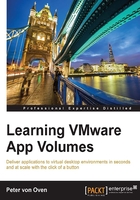
App Volumes use cases
There are several key use cases for deploying App Volumes within your environment.
The first of these use cases is deploying App Volumes within a virtual desktop infrastructure environment.
VDI desktops
A virtual desktop infrastructure (VDI) is the primary use case for App Volumes. It allows IT administrators to deploy applications in real time and independent of the core operating system. The decision on who gets which applications is based on the user and group policies, depending on the user's membership in Active Directory.
So why is this important and a key use case?
In order to deploy the most optimized VDI, you would want to opt for a floating, non-persistent model. This means that virtual desktop machines are delivered on demand from a pool of available machines and that nobody owns their own desktop. Everything is delivered on demand, and when the user logs off the virtual desktop machine gets destroyed, ready for the next user to log on.
This model would suit the majority of users; however, there are some users, such as developers, who would still require a persistent virtual desktop machine so that they have the ability to install their own applications that will remain when they log off rather than being destroyed when the virtual desktop machine they have been using gets destroyed. Deploying these types of virtual desktop machines is more costly and puts a greater load on infrastructure resources as you need more computing power and more storage than you would in a non-persistent deployment.
By deploying App Volumes, and the Writable Volumes feature in particular, users essentially get their own hard drive with their own user-installed applications on that drive. As they log on to a non-persistent, floating virtual desktop, their writable volume or hard drive gets attached and mounted to that virtual desktop machine. To the user, it looks as if their applications are natively installed on their desktop and that it is their own desktop.
The end users also benefit from having their core applications delivered immediately, and for the IT department, this means they can easily manage application delivery in real time, allowing them to assign new applications on the fly as well as deploy any updates to existing applications.
Allowing users to work with this model of virtual desktop machine deployment also means that the overall infrastructure requirements, particularly storage, are significantly lowered.
It's also important to note that we are not just talking about VMware virtual desktop solutions. App Volumes also supports Citrix environments, and can be purchased specifically for this, which we will cover in the How to license App Volumes section of this chapter.
RDSH-delivered applications
This particular use case is one that often gets overlooked since Remote Desktop Services Host (RDSH) is in itself an application-delivery mechanism. So how can App Volumes help with this use case?
If you look at the basic infrastructure around RDSH, applications have to be installed onto the RDSH server before they can be published to the end users. This in itself makes the infrastructure pretty static in nature. By static we mean that if you need to scale up your RDSH deployment, you not only have to build a new server but also install the applications all over again afterwards. It's a similar story when you have to update applications.
App Volumes, in this use case, works in the same way it would with a VDI, but instead of mounting AppStacks on the virtual desktop machine's operating system this time you are mounting them on the RDSH server. It's just a case of installing the App Volumes Agent and capturing an AppStack for use in this environment. Obviously, your RDSH servers need to be running as virtual machines.
Essentially, you are creating a stateless RDSH server that allows you to add additional server resources and just mount the AppStacks on them rather than having to install the applications each time.
Citrix XenDesktop and XenApp environments
We already mentioned that App Volumes can be deployed in a Citrix environment and can deliver exactly the same benefits. XenDesktop-based virtual desktop machines work in exactly the same way as a VMware Horizon View virtual desktop machine when it comes to delivering applications; however, you can now support the Virtual Hard Disk (VHD) format.
XenApp works using the functionality of an RDSH server. This means that you can now deploy stateless XenApp Servers by mounting AppStacks to RDSH servers, as we discussed previously. Like XenDesktop deployments, this can also be done using VHD deployments if you use a virtualization platform based on XenServer or Hyper-V.
Project A2
Announced at VMworld in 2015 as a tech preview, Project A2 brings together AirWatch enterprise mobile management (EMM) and VMware App Volumes to deliver mobile-like management for their Microsoft Windows 10 devices and applications.